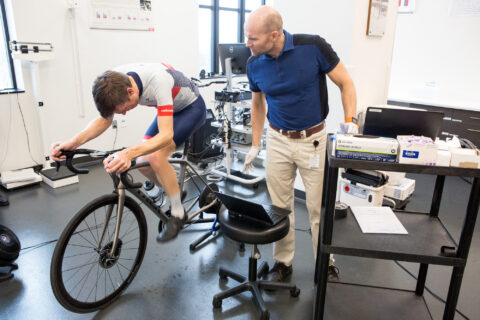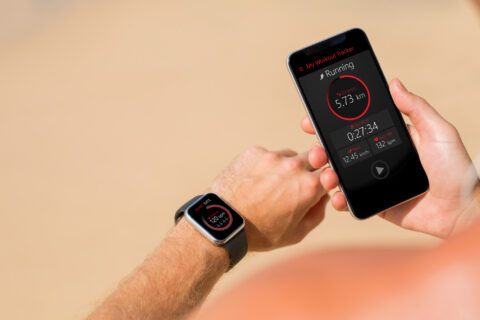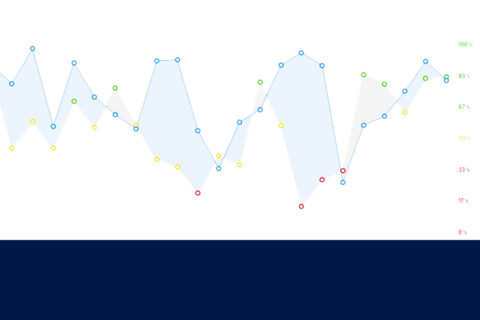Coaches Trevor Connor and Ryan Kohler analyze data from three of Trevor’s 20-minute power tests. One test went according to plan, while the others were a bit disappointing. Together, they offer important lessons on how to determine your FTP based on this test protocol, and on the proper execution of these intervals.
Ride data will reflect external factors like life stress or poor sleep, and learning how that comes across in the graphs can be confusing.
Ryan and Trevor point out the key attributes they look for when trying to help their athletes (and in this case, Trevor) better understand their data.
You can also see Ryan and Trevor’s discussion of their own Alpe du Zwift 20-minute FTP Test results in the Workout Lab Forum.
Video Transcript
Intro 00:07
Welcome to Fast Talk Laboratories, your source for the science of cycling performance.
Trevor Connor 00:14
So today I am going to talk a little bit about how to use a 20-minute effort to determine your threshold power and your threshold heart rate. I know that’s a really popular test to do, there are some pitfalls with it, I’ve seen athletes, a lot of times, use it, just take that average power from the 20-minute test and go, “okay, there’s my threshold power, or my FTP power,” and get themselves in trouble. Even I’ve sometimes seen athletes do what’s recommended, which is to take that average power from the 20- minute test, then multiply it by .95, and say, “now I’ve got my functional threshold power,” and go with that, because that’s not always accurate. So, I do personally use a 20-minute test, but there are certain things I look for to indicate whether that that multiplying by .95, which and I should give credit here, that is something that Dr. Coggan and Hunter Allen came up with, but there are times where that’s not enough, there are times when that’s too much, so let me show you how I do this and what I look for.
Clearing Out Anaerobic Energy To Get a More Precise 20- Minute Power Test
Trevor Connor 01:24
And so right now you’re looking at a good test, I have actually used Neal Henderson’s for 4DP test. His reasoning for that test is you do multiple metrics, so you start with several five second sprints, to get that top neuromuscular power, then you do a five-minute effort, which is that decent estimate of what we call Vo2 max power, then you do a 20-minute test to get that estimate of your FTP Power, and then finally, you do the one-minute test just to really hurt. It is a painful test. Neal and I are the same and that we like to torture ourselves and torture our athletes, so this was just a fun way to do it. The reason I really liked this test is you can see here, the five-minute effort and the order is very important. Then you take about a 10-to-15-minute rest, then you do the 20-minute test, and the reason I like that is because that 20-minute test we’re trying to get at your, the top end of your aerobic system, like what you can generate sustainably, mostly with aerobic energy is the way to think about it here. You don’t want that much of an anaerobic contribution, so I find doing that five-minute effort beforehand, kind of clears out some of that anaerobic energy, and then you’re gonna get a truer 20-minute test, showing something closer to the sort of aerobic power you’d put out. Ryan, what’s been your experience with that?
Ryan Kohler 02:57
I personally hate my 20-minute tests. I can never, I don’t like riding for 20 minutes that hard.
Trevor Connor 03:03
Yeah, you’re not a time trialer.
Ryan Kohler 03:05
I don’t have a lot of tests like this in my WKO. But yeah, you’re right, the five-minute, usually after that, I just want to be done, If I could take my FTP from that, it would be perfect. But yeah, you’re right, for someone like me that’s not steady, I think I’ve done 20-minute tests in the past, and it always overestimates if I don’t do something to you know, clear out that anaerobic contribution early on.
Trevor Connor 03:32
Yeah. Yeah, so that’s a good point. It’s important to know yourself as an athlete. I’m a pure time trialist, so what I do for 20 minutes is actually pretty close to my threshold power, if I did an hour test, my power is actually not that much higher than my 20-minute power. For somebody like Ryan, who’s got a bigger anaerobic engine, if he just took that power, it’s going to overestimate him because he’s gonna have a big anaerobic contribution. That again, I like this five-minute effort to kind of clear some of that system out, and you can even see with me as a pure time trialist, even my five-minute effort isn’t that much higher than my 20-minute effort, I kind of have one speed.
A Good Test Is One That Shows a Steady Heart Rate
Trevor Connor 04:14
So, this is an example of a good test, what I’m looking for is relatively steady wattage, which you see over here, but rather, what I really want to see is that heart rate. What you’ll see is it comes up over the first minute or two, then, you know, it’s never perfectly flat, but you’ll see it’s flatter, relatively steady. I already had a good sense of my threshold power, so you see this dotted or threshold heart rate, you see this dotted red line, which is what I know to be my threshold heart rate, and you can see I’m kind of sitting right on that line, I start a little below it, as I get later in the test, I get a little above it, but not crazy above it, and overall, it’s a fairly steady line.
Trevor Connor 05:01
So the first thing I do if, if I look at this and go, okay, this was a good test, the first thing I’m going to do with an athlete is actually take this kind of middle stretch, I want to eliminate that first part where, this is called your oxygen deficit, where your heart rate is taking a little bit of time to come up, I want to eliminate that, I also want to eliminate the end, because you come in in the last couple minutes you have time to go a little harder. So those aren’t good places, in my opinion, to take heart rate. So, I’m going to take this middle segment, where the heart rates fairly level, and then I’m going to look over here and go, okay, average 172 beats per minute, which I know actually my threshold heart rates is right around 171-172, so good test, and this is what I would use to determine that threshold heart rate. Then I am going to look at that average power for that 20 minutes, so go over here, 327, I would not put that in as my threshold power. In this case, I would go this is a pretty good test, as I was saying before, it’s pretty steady, so this is where I might multiply it by .95. Knowing myself as a pure time trialist, I might actually go a little bit higher than that. But it’s going to be somewhere for me, I would look at this and go my threshold power is probably about 350.
Anaerobic Contribution
Trevor Connor 06:30
So, let’s look at a test where I would say things didn’t go as well, or this is what you might see in somebody like Ryan, this is where you have to be careful. So, you can see there’s my big five-minute, you can see I managed to put out some really good power, here’s my, and let’s zoom in a little bit here. We’re not looking at this one-minute effort today. Take a look at my heart rate here, you can see I never get that leveling off, so it takes a little bit to come up, but it just keeps going up, and you can see it gets up. I’m hitting 180-182 beats per minute, which again, I know my threshold is right around 171-172, so to go from starting right about here, I’m 167 to go all the way up to 182, that’s not steady. That is a constantly rising heart rate. So, what this is telling me is there was more of an anaerobic contribution, I was having a good day, legs were feeling good, I wish I had actually been in a race on this day, because I was able to ride above myself. But this is not truly representative of my threshold power, my aerobic energy system. This is yeah, there was a big anaerobic contribution here. So, if I took that 20 minutes, so you’ll notice powers actually not too different from the one I just showed you, but I had very different fitness levels. These are different years. So, on this particular day, 333 was too high for me, and I would set my threshold power much lower, I would probably even go lower than multiplying by .95, or just say this wasn’t a great test, I had too much anaerobic contribution. So, I’m not going to trust these results too much. Some athletes, this is what you’ll always see because they have a good anaerobic system. So, you’re gonna have to use this but this is where you have to be careful and say I’m going to be a little more conservative and go lower than just multiplying by the .95. Certainly not going to take that 333, and say that’s my threshold power, my FTP, you look at my heart rate there, there’s no way I could do that for an hour.
Looking For a Flat and Steady Heart Rate Versus One That Is Continually Rising
Trevor Connor 08:58
So that’s two things to look for, is how flat and steady is the heart rate versus is it continually rising that tells you a bit about the energy contribution. You can see I did this inside, make sure you’re hydrating because otherwise if you’re dehydrated and senseless, I didn’t have the fan on it wasn’t drinking water, this could just be indicative of the fact that I’m losing fluid volume. So, when I do these tests, I’m very careful to have several fans on me and drink a lot of fluid.
Trevor Connor 09:30
Now let’s look at just a couple completely failed tests where I’d say I wouldn’t even use this data. So, here’s one, and I don’t you can’t see my description of this, but I read my description right before we started here, and I basically said I felt awful I didn’t sleep well the night before, I’m not sure I why I went through with this, and this shows that. So, you can see over here, here’s my five-minute effort, it’s all over the map. You can see I was struggling, never really touched threshold heart rate, that was about it. But look at my 20-minute effort. Again, you can see all these little spikes and efforts, this is not as steady an effort, so that to me is a sign since I’m a time trial style rider, and I’m really good at going steady, this indicates to me that I was struggling the whole time. And then look at my heart rate, I didn’t hit threshold until the very end, that tells me I was just having a sluggish day, I wasn’t feeling good, I probably should have turned around gone home and done this test another day.
Looking For the Response of Heart Rate, Steadiness, and Leveling Of the Heart Rate
Trevor Connor 10:35
So, one last one, just to show you a true epic failure. And I’m not sure why I went as far as I did, because the signs were all there, but again, you can see over here, I actually got through the five-minute effort it looks like but look how low my heart rate was. So there again, you can just see, I was struggling. Looking at the power, yeah, I got through it, but knowing what I generally do in the five- minute effort, that was pretty bad. So, I should have looked at this at low heart rate power was not good. I should, at this point turned around and gone home. Here’s the 20-minute effort, and I don’t even think I finished it. Yeah, I got through about 14 minutes and finally woke up and said, “What am I doing here?” And stopped and ended it there. But you can see I never even touched threshold heart rate, this was not a good test, and I realized it and I pulled the plug. So, these are the things to look for, you want to see that response of heart rate, you want to see that steadiness, you also want to see that leveling of the heart rate, that’s a really good test. If you don’t see that leveling, that means you had much more of an anaerobic contribution, means you were over threshold, more than that good, steady effort. So you need to when you’re setting your FTP or threshold power, compensate accordingly.
Ryan Kohler 12:12
That’s awesome. Yeah, that’s a great range of tests to look at, and I like yeah, the one where you highlighted where the heart rate continually rose, I think you hit like 181 on that effort? That one definitely hits home because I know Yeah, like you said, the more anaerobic type of athletes, they’re gonna experience some of this, and I think it looks like this is one of those traps we could fall into to say, hey, this was an awesome day, heartrate be damned I’m going to set my FTP at .95, but it’s going to be overestimated. I know, I’ve had days like this, and from doing it a lot, you know, I’ve learned to adjust like, maybe it’s not .95, it’s something else, but yeah, I’ve learned to accommodate that. And one other thing that I like to do with this is, you know, for someone who has more of that anaerobic capability where we see a test like this is then you know, I’ll go out and do some longer efforts to and I’ll take, I’ll start looking at like 60-minute, 90-minute power from some hard rides and say, “Okay, what can I really sustain over the long term?” And then I’ll bring that into the equation and say, “Well, yeah, this is telling me that my threshold is 315, I absolutely know it’s not 315.” So, let me ride hard for 60-90 minutes, two hours, and see what that power looks like.
Trevor Connor 13:24
No, those are all good points. The other thing you reminded me of is it’s important to know the rider goals. So, we talked about the type of rider you are, but also what you’re trying to accomplish. So, if I had a track rider go out and do this effort, do the 20- minute and they looked like this, I’d be like, okay, your track rider, this is fine. If somebody came to me and said my focus is a 40k time trial, and I saw a heart rate like this, I would go we’ve really got to work on that.





